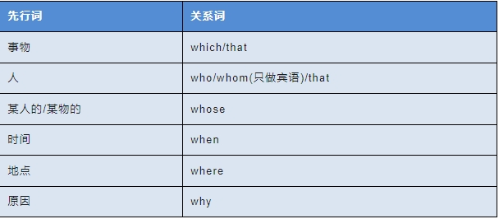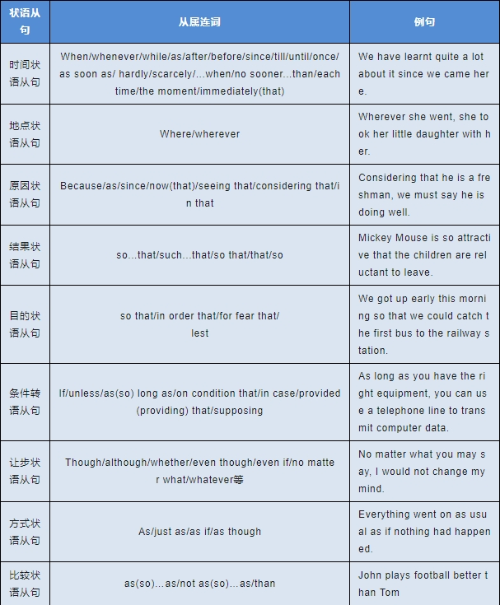

【摘要】在考研备考过程中,英语语法是必备。涉及到阅读、翻译和长难句,今天新航道小编为大家说说关于考研常用基础语法
【关键词】考研英语
在考研备考过程中,英语语法是必备。涉及到阅读、翻译和长难句,今天新航道小编为大家说说关于考研常用基础语法,适合基础比较弱的同学,大家一起来看看吧。
十大词性
noun名词:n.
pronoun代词:pron. 用于代替名词(we、that、all、witch)
numeral数词:num.
article冠词:art.,加在名词或名词之前的 a、an、the
verb动词:v.
advert 副词:adv. 修饰动作的词 (next、much、)增加程度等
adjective形容词:adj.
preposition介词:prep. (at in on)
conjunction连词:conj. (and、also、but)
Interjection感叹词(无语法内容):int
九种成分
(1)实意动词:
*有实际含义:吃喝玩乐
*单独做谓语:不及物动词vi. 及物动词vt.
(2)系动词
be动词:am/is/are
get/become/turn/go/grow:变得XX
look/sound/semll/taste/feel:XX起来
keep/remain/stay/seem/appear/prove/turn out:保留保持、似乎、结果是
3、宾语:承受动作的词
4、定语:定语是用来修饰、限定、说明名词或代词的品质与特征的。一般译为XX的。
5、状语:从情况、时间、处所、方式、条件、对象、肯定、否定、范围和程度等方面对谓语中心词进行修饰、限制。
6、表语:表语是紧跟系动词之后的。
7、补语:补语是对宾语的补充说明。
8、双宾语:双宾语就是直接宾语+间接宾语。其中直接宾语承受谓语动词的动作,间接宾语表示这个动作的方向或者目标。比如:I bought my mother a TV.
9、同位语:两个东西有同样的地位。
谓语的三态

1.谓语动词的时态
2.谓语动词的情态
can (could), may (might), must, need, ought to, dare (dared), shall(should), will (would)
3.谓语动词的语态
(1)主动语态:表示主语是动作的发出者。
(2)被动语态:被动语态中的主语是谓语动作的承受者。
五大基本句型与并列句
(一)五大基本句型
1.不及物动词:主语+谓语。比如:I sleep.
2.及物动词:
(1)主语+谓语+宾语。比如:I love u.
(2)主语+谓语+宾宾(人+物)。比如:I give you some money.
(3)主语+谓语+宾语+宾补. 比如:I make you happy.
3.系动词:主语+系动词+表语。比如:You are beautiful.
(二)并列句
1、并列连词:
(1)表承接:and/both..and.../not only...but...as well/not only...but (also)
(2)表转折:but/yet
(3)表选择:or/either or/neither or
(4)表因果:for/so
2、如何构成并列句:并列句可以并列多件事,仅需依次加入并列连词。如果多个并列连词相同,只保留最后一个,前面的换为逗号,比如a,b,c and d.
3、并列句独有的省略:
*如果并列句中的左右两个分句虽然主语不同,但有相同的be动词,那么可以省略连词和后一个分句的be动词。
比如:Its scientists were the world’s best, (省略and) its workers (省略were) the most skilled.
*如果并列句中左右两个分句出现重复的部分,那么后一个分句可以省略重复的部分,但是没有重复的部分要保留。
比如:Do you remember all those years when scientists argued that smoking would kill us but the doubters insisted that we did not know (省略that smoking would kill us) for sure?
*在并列句中后边的分句可以省略与前边分句中相同的成分。
比如:Your behavior made me happy but (省略your behavior made) Tom angry.
六大从句
(一)主语从句
主从句的含义:用一个句子作主语,把这个句子放在主句当中。
主语从句的位置:一般放在句首,但是如果主语从句太长了,就要主语后置,并用形式主语it在句首占位。
可以这样写一个主语从句:
1.表达对一件事的看法或观点:It is done + 主语从句. 比如:
It is said that comic books create a connection between people of the same generation.
It seems that the performance is very useful.
2.表达对一件事的评价:It is +adj/n. +主语从句. 比如:
it is argued in the contemporary world that……
It is not yet clear that…….
(二)宾语从句
1、宾语从句的含义:用一个句子作宾语,把这个句子放在主句当中。
2、宾语从句的位置:宾语从句可位于及物动词、介词和某些形容词后。如果宾语从句太长了,可以用it做形式宾语,然后把宾语向后放。
3、可以这样写一个宾语从句:
(1)陈述句变成宾语从句时,直接用that,that常可省略。
(2)介词后面接疑问词引导的宾语从句。注意:in that(因为),except that(除了),but that(只是)是固定搭配,其他介词后一般不接that引导的宾语从句。比如:
All this is different from what American young people would say about friendship.
This article is well-written except that it is a bit too long.
(3)宾语从句后如有宾补,要用形式宾语it来代替,而把宾语从句移至宾补之后。比如:
He has made it clear that he would not change his mind.
(4)在think,believe,suppose,expect等动词后的宾语从句中,如果谓语是否定的,一般将否定词移至主句谓语上,宾语从句变成肯定形式。
(三)表语从句
表语从句的含义:用一个句子作表语,把这个句子放在主句当中。
表语从句的位置:系动词之后
可以这样写一个宾语从句:
1.表语从句除可that,what,when,why,whether,how等引导。比如:
Perhaps the most important thing to remember is that there is no one common type of life in America.
2.此外,还可由because,as if(though)等引导。
It looks as if successful international cultural communication will make the world smaller.
3.如主句主语为reason,只能用that引导表语从句,不可用because.
The reason why so many people died there is that there were not enough food supplies.
(四)同位语从句
同位语从句的含义:用一个句子作同位语,把这个句子放在主句当中,来解释前面的名词。
同位语从句的位置:需要解释的抽象名词后。
同位语从句的写法:
1.一般用连词that引导。比如:
She finally made the decision that she would join the fashion show.
2. 也可用whether,who,when,where,what,why,how等引导。常见的先行名词有fact,idea,belief,news,hope,conclusion,evidence,suggestion,order,problem,report,decision.比如:
I had no idea how many books I could borrow at a time.
3.有时由于谓语较短,将同位语从句位于谓语之后。比如:
The news came that their team had won the championship.
(五)定语从句

定语从句的含义:用一个句子做定语,就近修饰限定名词。
定语从句的关系词:
1.每一个关系词都做成份,包括that,that可以指人也可以指物
2.whom只能作宾语
3.关系词作宾语都可以省略
4.特殊关系词:whereby=by which
定语从句的分类:
1.限定性定语从句:修饰先行词,对先行词起修饰作用,紧接先行词之后,无逗号,若省去则原句意思不完整。比如:
He will call his friend who is working in London.
(1) 只能用that引导从句的情况:
当先行词是all,anything,everything,something,nothing等不定代词或先行词前有first,last,any,few,much,some,no,only以及形容词最高级修饰时,只能用关系代词that引导从句。比如:
That is all that I've heard from him.
He's the first person that I'm going to interview this afternoon.
(2)关系代词的省略:
在从句中作宾语的关系代词常可省略。关系代词紧跟介词,作介词宾语时不可用that,只可用which或whom引导从句,并且不可省略,但当介词位于宾语从句句末时,作为介词宾语的关系代词仍可用that,也可省略。比如:
This is one of those things with which we have to put up.
This is one of those things (which\that) we have to put up with.
(3)关系副词作状语:
引导定语从句的关系副词有when,where,why等。关系副词在从句中作状语,意义上相当于一个“介词+which”的结构。比如:
Even in comic books where(=in which) there are no words,the stories are fully expressed through the drawings.
No one knows the reason why(=for which) he was so angry that day.
2.非限定性定语从句:既可修饰先行词,也可修饰整个主句,起补充说明作用,与主句之间有逗号隔开,若省去,原句意思不受影响。比如:
he will call his mother, who is working in London.
(1)不可用that引导非限制性定语从句。关系词不可省略。比如:
Every object has a gravitational pull, which is rather like magnetism.
(2) “介词+which\whom\whose”可引导限制性定语从句,也可引导非限制性定语从句,该结构中介词的选择取决于从句谓语动词的固定搭配,或先行词的习惯搭配。比如:
This is the computer on which he spent all his savings
It is written by a person with whom we are all familiar.
3.as引导的定语从句:as引导的定语从句主要用于“such...as”及“the same...as”的结构中,代替先行词是人或物的名词。as引导非限制性定语从句时,代替整个主句,从句可位于主句之前、之后或中间。比如:
These are not such problems as can be easily solved.(as代替先行词problems)
As is mentioned above,no single company or group can control what happens on the Internet.(as代替主语)
(六)状语从句
定语从句的含义:用一个句子作状语,把这个句子放在主句当中,用以形容或描述。
定语从句的分类:

上一篇:如何掌握考研英语语法
下一篇:考研英语单词、语法怎么学更高效?